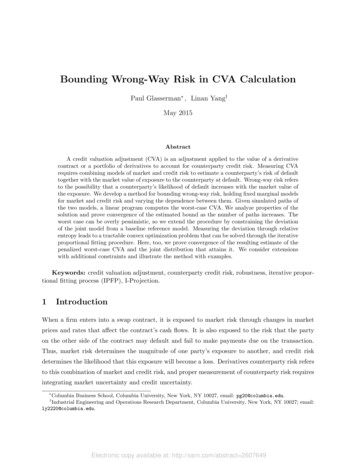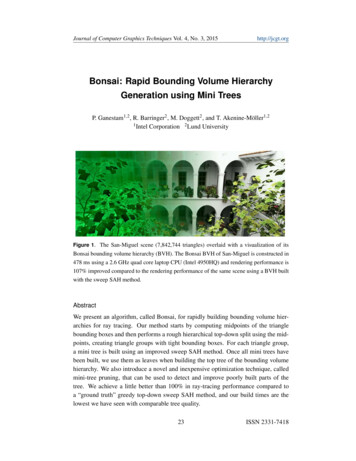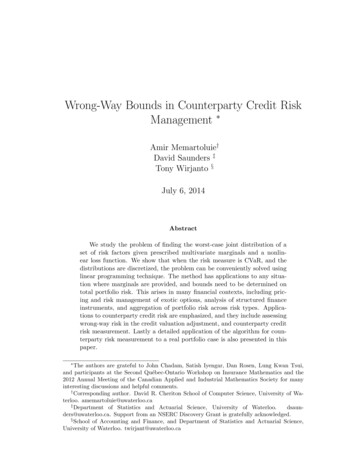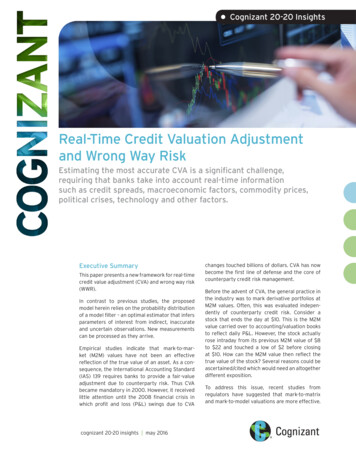
Transcription
Bounding Wrong-Way Risk in CVA CalculationPaul Glasserman , Linan Yang†May 2015AbstractA credit valuation adjustment (CVA) is an adjustment applied to the value of a derivativecontract or a portfolio of derivatives to account for counterparty credit risk. Measuring CVArequires combining models of market and credit risk to estimate a counterparty’s risk of defaulttogether with the market value of exposure to the counterparty at default. Wrong-way risk refersto the possibility that a counterparty’s likelihood of default increases with the market value ofthe exposure. We develop a method for bounding wrong-way risk, holding fixed marginal modelsfor market and credit risk and varying the dependence between them. Given simulated paths ofthe two models, a linear program computes the worst-case CVA. We analyze properties of thesolution and prove convergence of the estimated bound as the number of paths increases. Theworst case can be overly pessimistic, so we extend the procedure by constraining the deviationof the joint model from a baseline reference model. Measuring the deviation through relativeentropy leads to a tractable convex optimization problem that can be solved through the iterativeproportional fitting procedure. Here, too, we prove convergence of the resulting estimate of thepenalized worst-case CVA and the joint distribution that attains it. We consider extensionswith additional constraints and illustrate the method with examples.Keywords: credit valuation adjustment, counterparty credit risk, robustness, iterative proportional fitting process (IPFP), I-Projection.1IntroductionWhen a firm enters into a swap contract, it is exposed to market risk through changes in marketprices and rates that affect the contract’s cash flows. It is also exposed to the risk that the partyon the other side of the contract may default and fail to make payments due on the transaction.Thus, market risk determines the magnitude of one party’s exposure to another, and credit riskdetermines the likelihood that this exposure will become a loss. Derivatives counterparty risk refersto this combination of market and credit risk, and proper measurement of counterparty risk requiresintegrating market uncertainty and credit uncertainty. Columbia Business School, Columbia University, New York, NY 10027, email: pg20@columbia.edu.Industrial Engineering and Operations Research Department, Columbia University, New York, NY 10027; email:ly2220@columbia.edu.†Electronic copy available at: http://ssrn.com/abstract 2607649
Bounding Wrong Way Risk2The standard tool for quantifying counterparty risk is the credit valuation adjustment, CVA,which can be thought of as the price of counterparty risk. Suppose firm A has entered into a setof derivative contracts with firm B. From the perspective of firm A, the CVA for this portfolio ofderivatives is the difference between the value the portfolio would have if firm B were default-freeand the actual value taking into account the credit quality of firm B. More precisely, this is aunilateral CVA; a bilateral CVA adjusts for the credit quality of both firms A and B.Counterparty risk generally and CVA in particular have taken on heightened importance sincethe failures of major derivatives dealers Bear Stearns, Lehman Brothers, and AIG Financial Products in 2008. A new CVA-based capital charge for counterparty risk is among the largest changes tocapital requirements under Basel III for banks with significant derivatives activity (BCBS [1]). CVAcalculations are significant consumers of bank computing resources, typically requiring simulationof all relevant market variables (prices, interest rates, exchanges rates), valuing every derivative atevery time step on every path, and integrating these market exposures with a model of credit riskfor each counterparty. See Canabarro and Duffie [12] and Gregory [22] for background on industrypractice.Our focus in this paper is on the effect of dependence between market and credit risk. Wrongway risk refers to the possibility that a counterparty will become more likely to default when themarket exposure is larger and the impact of the default is greater; in other words, it refers topositive dependence between market and credit risk. Wrong-way risk arises, for example, if onebank sells put options on the stock of another similar bank. The value of the options increases asthe price of the other bank’s stock falls; this is likely to be a scenario in which the bank that soldthe options is also facing financial difficulty and is less likely to be able to make payment on theoptions. In practice, the sources and nature of wrong-way risk may be less obvious.Holding fixed the marginal features of market risk and credit risk, greater positive dependenceyields a larger CVA. But capturing dependence between market and credit risk is difficult. Thereis often ample data available for the separate calibration of market and credit models but littleif any data for joint calibration. CVA is calculated under a risk-adjusted probability measure,so historical data is not directly applicable. In addition, for their CVA calculations banks oftendraw on many valuation models developed for trading and hedging specific types of instrumentsthat cannot be easily integrated with a model of counterparty credit risk. CVA computation ismuch easier if dependence is ignored. Indeed, the Basel III standarized approach for CVA assumesindependence and then multiplies the result by a factor of 1.4; this ad hoc factor is intended tocorrect for several sources of error, including the lack of dependence information.Models that explicitly describe dependence between market and credit risk include in CVAElectronic copy available at: http://ssrn.com/abstract 2607649
1. Introduction3calculation include Brigo, Capponi, and Pallavicini [9], Crépey [15], Hull and White [25], and Rosenand Saunders [30]; see Brigo, Morini, and Pallavicini [10] for an extensive overview of modelingapproaches. Dependence is usually introduced by correlating default intensities with market riskfactors or through a copula. A direct model of dependence is, in principle, the best approach toCVA. However, correlation-based models generally produce weak dependence between market andcredit risk, and both techniques are difficult to calibrate.In this paper, we develop a method to bound the effect of dependence, holding fixed marginalmodels of market and credit risk. Our approach uses simulated paths that would be needed anywayfor a CVA calculation without dependence. Given paths of market exposures and information(simulated or implied from prices) about the distribution of time to the counterparty’s default, weshow that finding the worst-case CVA is a linear programming problem. The linear program is easyto solve, and it provides a bound on the potential impact of wrong-way risk. We view this in-samplebound based on a finite set of paths as an estimate of the worst-case CVA for a limiting problemand prove convergence of the estimator. The limiting problem is an optimization over probabilitymeasures with given marginals. We also show that the LP formulation has additional useful features.It extends naturally to a bilateral CVA calculation, and it allows additional constraints. Moreover,the dual variables associated with constraints on the marginal default time distribution provideuseful information for hedging purposes.The strength of the LP solution is that it yields the largest possible CVA value — the worstpossible wrong-way risk — consistent with marginal information about market and credit risk. Thisis also a shortcoming, as the worst case can be too pessimistic. We therefore extend the method bypenalizing or constraining deviations from a nominal reference model. The reference model couldbe one in which marginals are independent or linked through some simple model of dependence.A large penalty produces a CVA value close to that obtained under the reference model, and withno penalty we recover the LP solution. Varying the penalty parameter allows us to “interpolate”between the reference model and the worst-case joint distribution.To penalize deviations from the reference model, we use a relative entropy measure betweenprobability distributions, also known as the Kullback-Leibler divergence. Once we add the penalty,finding the worst-case joint distribution is no longer a linear programming problem, but it is stillconvex. Moreover, the problem has a special structure that allows convenient solution throughiterative rescaling of the rows and columns of a matrix. This iterative rescaling projects a startingmatrix onto the convex set of joint distributions with given marginals. Here, too, we prove convergence of the in-sample solution to the solution of a limiting problem as the number of pathsincreases.
Bounding Wrong Way Risk4The problem of finding extremal joint distributions with given marginals has a long and richhistory. It includes the well-known Fréchet bounds in the scalar case and the multivariate generalization of Brenier [8] and Rüschendorf and Rachev [33]; see the books by Rüschendorf [32] andVillani [36] for detailed treatments and historical remarks. In finance, related ideas have been usedto find robust or model-free bounds on option prices; see Cox [14] for a survey. In some versionsof the robust pricing problem, one observes prices of simple European options and seeks to boundprices of path-dependent or multi-asset options given the European prices, as in Carr, Ellis, andGupta [13], Brown, Hobson, and Rogers [11], and Tankov [35], among many others. This has motivated the study of martingale optimal transport problems in Dolinsky and Soner [18], Beiglböckand Juillet [2], Henry-Labordère and Touzi [24]. The literature on price bounds focuses on extremalsolutions and does constrain or penalize deviations from a baseline model.Our focus is not on pricing but rather risk measurement. Within the risk measurement literature, questions of joint distributions with given marginals arise in risk aggregation; see, for example,Bernard, Jiang, and Wang [4], Embrechts and Puccetti [20], and Embrechts, Wang, and Wang [21].A central problem in risk aggregations is finding the worst-case distribution for a sum of randomvariables, given marginals for the summands.Our work differs from earlier work in several respects. We focus on CVA, rather than optionpricing or risk aggregation. Our marginals may be quite complex and need not be explicitly available — they are implicitly defined through marginal models for market and credit risk. Given thegenerality of the setting, we do not seek to characterize extremal joint distributions but rather toestimate bounds using samples generated from the marginals. We temper the bounds by constraining deviations from a reference model, drawing on the idea of robustness as developed in economicsin Hansen and Sargent [23] and distributional robustness as developed in the optimization literature in Ben-Tal et al. [3] and references there. The methods we develop are easy to implementin practice. The main contribution lies in the formulation and in the convergence analysis. Ourgeneral approach to convergence is to use primal and dual optimization problems to get upper andlower bounds.The rest of the paper is organized as follows. In Section 2, we introduce the problem setting,and in Section 3 we introduce the optimization formulation for the worst case CVA bound and showconvergence of the bound estimator. In Section 4, we extend the problem to a robust formulationwith a relative entropy constraint, and we provide numerical examples in Section 5. In Section 6,we extend the model further to incorporate expectation constraints.
2. Problem Formulation25Problem FormulationLet τ denote the time at which a counterparty defaults, and let V (τ ) denote the value of a swap(or a portfolio of swaps and other derivatives) with that counterparty at the time of its default,discounted to time zero. The swap value could be positive or negative, so the loss at default is thepositive part V (τ ). The CVA for a time horizon T is the expected exposure at default,CVA E[V (τ )1{τ T }],(2.1)given a joint law for the default time τ and the exposure V . Our focus will be on uncertaintyaround this joint law, but we first provide some additional details on the problem formulation.CVA is customarily calculated over a finite set of dates 0 t0 t1 · · · td T td 1 ;for example, these may be the payment dates on the underlying contracts. An underlying simulation of market risk factors generates paths of all relevant market variables and is used to generateexposure paths (V (t1 ), . . . , V (tK )). Calculating these exposures is a demanding task because itrequires valuing all instruments in a portfolio with a counterparty in each market scenario at eachdate. In addition, the calculation of each V (tj ) needs to account for netting and collateral agreements with the counterparty and recovery rates if the counterparty were to default. The methodwe develop takes these calculations as inputs and assumes the availability of independent copies ofthe exposure paths. The market risk model implicitly determines the law of (V (t1 ), . . . , V (td )),and we denote this law by a probability measure p on Rd .The distribution of the counterparty’s default time τ may be extracted from credit default swapspreads, or it may be the result of a more extensive credit risk model — for example, a stochasticintensity model. In either case, we suppose that a credit risk model fixes the probabilities qj ,j 1, . . . , d, that default occurs at tk , or, more precisely that it occurs in the interval (tk 1 , tk ].LetX (V (t1 ), . . . , V (td )) and Y (1{τ t1 }, . . . , 1{τ td }).The problem of calculating CVA would reduce to the problem of calculating the expectation of theinner product X, Y dXV (tj )1{τ tj } V (τ )1{τ T },j 1if the joint law for X and Y were known. With the marginals fixed but the joint law unknown, weseek to evaluate the worst-case CVA, defined byZCVA : sup x, y dµ(x, y),µ Π(p,q) Rd Rd(2.2)
Bounding Wrong Way Risk6where Π(p, q) denotes the set of probability measures on Rd Rd with marginals p and q.The characterization of extremal joint distributions with given marginals has a rich history; seeVillani [36] and Rüschendorf [32] for recent treatments with extensive historical remarks. In thescalar case d 1, the largest value of (2.2) is attained by the comonotonic construction, whichsets X Fp 1 (U ) and Y Fq 1 (U ), where Fp and Fq are the cumulative distribution functionsassociated with p and q, and U is uniformly distributed on [0, 1]. The smallest value of (2.2) isattined by setting Y Fq 1 (1 U ) instead. In the vector case, a characterization of joint lawsmaximizing (2.2) has been given by Brenier [8] and Rüschendorf and Rachev [33]. It states thatunder an optimal coupling, Y is a subgradient of a convex function of X, but this provides more ofa theoretical description than a practical characterization. Our setting has the added complicationthat at least p (and possibly also q) is itself unknown and only implicitly specified through asimulation model.3Worst-Case CVA3.1EstimationWe develop a simulation procedure to estimate (2.2). As we noted earlier, generating exposurepaths is the most demanding part of a CVA calculation. Our approach essentially reuses thesepaths to bound the potential effect of wrong-way risk at little additional computational cost.Let X1 , . . . , XN be N independent copies of X, and let Y1 , . . . , YN be N independent copies ofY . Denote their empirical measures on Rd byN1 XpN (·) 1{Xi ·},Ni 1N1 XqN (·) 1{Yi ·},N(3.1)i 1For notational simplicity, we will assume that p has no atoms so that, almost surely, there areno repeated values in X1 , X2 , . . . . This allows us to identify the empirical measure pN on Rdwith the uniform distribution on the set {X1 , . . . , XN } or on the set of indices {1, . . . , N }. Theassumption that p has no atoms is without loss of generality because we can expand the dimensionof X to include an independent, continuously distributed coordinate Xd 1 and expand Y by settingYd 1 0 without changing (2.2).Observe that Y is supported on the finite set {y1 , . . . , yd 1 }, with y1 (1, 0, . . . , 0), . . . , yd (0, 0, . . . , 1), and yd 1 (0, . . . , 0). Each yj has probability q(yj ). These probabilities may beknown or estimated from simulation of N independent copies Y1 , . . . , YN of Y , in which case wedenote the empirical frequency of each yj by qN (yj ).We will put a joint mass function PijN on the set of pairs {(Xi , yj ), i 1, . . . , N , j 1, . . . , d 1}.We restrict attention to the set Π(pN , qN ) of joint mass functions with marginals pN and qN . We
3.2Dual Variables7estimate (2.2) using[ CVAN Xd 1XmaxP N Π(pN ,qN )PijN Xi , yj .i 1 j 1Finding the worst-case joint distribution is a linear programming problem:max{Pij }subject toN Xd 1XCij Pij ,(3.2)i 1 j 1d 1XPij 1/N, i 1, ., N,(3.3)j 1NXPij qN (yj ), j 1, ., d 1and(3.4)i 1Pij 0, i 1, ., N, j 1, ., d 1,(3.5)with Cij Xi , yj . In particular, this has the structure of a transportation problem, for whichefficient algorithms are available, for example a strongly polynomial algorithm; see Kleinschmidtand Schannath [27]. Bilateral CVA, involving the joint distribution of market exposure and thedefault times of both parties, admits a similar formulation.3.2Dual VariablesTo formulate the dual problem, let ai and bj be dual variables associated with constraints (3.3) and(3.4), respectively. The dual problem is thenmina RN ,b Rd 1subject toNXai /N d 1Xi 1bj qN (yj )j 1ai bj Cij , i 1, ., N, j 1, ., d.The dual variables are useful because they measure the sensitivity of the estimated worst-caseCVA to the marginal constraints. Consider any vector of perturbations ( q1 , . . . , qd 1 ) to themass function qN with components that sum to zero. Suppose these perturbations are sufficientlysmall to leave the dual solution unchanged. Then[ CVAd 1Xbj qj .j 1In particular, we can calculate the sensitivity of the worst-case CVA to a parallel shift in the creditcurve by setting qj , j 1, . . . , d, and qd 1 d , for sufficiently small .
Bounding Wrong Way Risk3.38Convergence as N [ based on N simulated paths. ButThe solution to the linear program provides an estimate CVAwe are ultimately interested in CVA in (2.2), the worst-case CVA based on the true marginallaws for market and credit risk, rather than their sample counterparts. We show that our estimateconverges to CVA almost surely as N increases.Although in our application Y has finite support, we state the following result more generally.For probability laws p and q on Rd , let pN and qN denote the corresponding empirical laws in (3.1).Let Π(p, q), Π(pN , qN ), and Π(pN , q) denote the sets of probability measures on Rd Rd with theindicated arguments as marginals.Theorem 3.1. Let X and Y be d-dimensional random vectors with distributions p and q respectivelyRRsuch that Rd kxk2 dp(x) , and Rd kyk2 dq(y) . ThenZZ x, y µ(dx, dy) x, y µ(dx, dy) limsuplimsupN µ Π(p ,q) Rd RdNN µ Π(p ,q ) Rd RdN NZ sup x, y µ(dx, dy).µ Π(p,q) Rd RdThe proof follows from results on optimal transport in Villani [36]; see Appendix A.4Robust Formulation with a Relative Entropy ConstraintThe linear program (3.2)–(3.5) provides a simple way to bound the impact of wrong-way risk andestimate a worst-case CVA, and Theorem 3.1 establishes the consistency of this estimate as thenumber of paths grows. An attractive feature of this approach is that it reuses simulated exposurepaths that need to be generated anyway to estimate CVA even ignoring wrong-way risk.A drawback of the bound CVA is that it may be too pessimistic: the worst-case joint distribution may be implausible, even if it is theoretically feasible. To address this concern, we extendour analysis and formulate the problem of bounding wrong-way risk as a question of robustness tomodel uncertainty. By controlling the degree of uncertainty we can temper the bound on wrong-wayrisk.4.1Constrained and Penalized ProblemsIn this formulation, we start with a reference model for the dependence between the market andcredit models and control model uncertainty by constraining deviations from the reference model.To be concrete, we will assume that the reference model takes market and credit risk to be independent, though this is not essential. We use ν to denote the corresponding element of Π(p, q) that
4.1Constrained and Penalized Problems9makes X and Y independent; in other words,ν(A B) p(A)q(B),for all measurable A, B Rd .To constrain deviations from the reference model, we need a notion of “distance” betweenprobability measures. Among the many candidates, relative entropy, also known as the KullbackLeibler divergence, is particularly convenient. For probability measures P and Q on a commonmeasurable space and with P Q, define the entropy of Q relative to P to be dQdQdQ EQ ln,lnD(Q P ) EPdPdPdPthe subscripts indicating the measure with respect to which the expectation is taken. Relativeentropy is frequently used to quantify model uncertainty; see, for example, Hansen and Sargent[23] and Ben-Tal et al. [3]. Relative entropy is not symmetric in its arguments, but this is notnecessarily a drawback because we think of the reference model as a favored benchmark. We areinterested in the potential impact of deviations from the reference model, but we do not necessarilyview nearby alternative models as equally plausible. Relative entropy D(Q P ) is convex in Q, andthis will be important for our application. Also, D(Q P ) 0 only if Q P .To find a tempered worst case for wrong-way risk, we maximize CVA with the marginal modelsp and q held fixed and with a constraint η 0 on the relative entropy divergence from the referencejoint model ν:ZCVAη : x, y dµ(x, y),sup(4.1)µ Π(p,q) Rd RdZsubject toln(dµ)dµ η.dν(4.2)At η 0, the only feasible solution is the reference model µ ν. At η , the problem reducesto the worst-case CVA of the previous section. Varying the relative entropy budget η thus controlsthe degree of model uncertainty or the degree of confidence in the reference model.We are actually interested in solving this problem for a range of η values to see how the potentialimpact of wrong-way risk varies with the degree of model uncertainty. For this purpose, it will beconvenient to work with a penalty on relative entropy rather than a constraint. The penaltyformulation with parameter θ 0 is as follows:Zsupµ Π(p,q) Rd Rd1 x, y dµ(x, y) θZln(dµ)dµ.dν(4.3)
Bounding Wrong Way Risk10The penalty term subtracted from the linear objective is nonnegative because relative entropyis nonnegative. At θ 0, the penalty would be infinite unless µ ν; at θ , the penalty dropsout and we recover the worst-case linear program of Section 3. A related problem appears in Boscand Galichon [7], but without a reference model ν. The correspondence between the constrainedproblem (4.1)–(4.2) and the penalized problem (4.3) is established in the following result, provedin the Appendix B:Proposition 4.1. For θ 0, the optimal solution µθ to (4.3) is the optimal solution to (4.1)–(4.2)withZη(θ) ln(dµθ)dµθ .dν(4.4)The mapping from θ to η(θ) is increasing, and η(θ) (0, η ] for θ (0, ), where η is (4.4)evaluated at the solution to (2.2).In the following, we write CVAθ instead of CVAη(θ) for θ (0, ). To estimate CVAθ , weform a sample counterpart, modifying the linear programming formulation (3.2)–(3.5). We denotethe finite sample reference joint probabilities by Fij . In the independent case, these are given byFij qN (yj )/N , i 1, . . . , N , j 1, . . . , d 1. Let P θ denote the optimal solution to the followingoptimization problem:max{Pij }N Xd 1Xi 1 j 1N d 1 P 1 XXijsubject to (3.3)-(3.5).Pij lnCij Pij θFij(4.5)i 1 j 1We estimate CVAθ by[ θ : CVAN Xd 1XCij Pijθ .i 1 j 14.2Iterative Proportional Fitting ProcedureThe penalty problem (4.5) is a convex optimization problem and can be solved using generaloptimization methods. However, the choice of relative entropy for the penalty leads to a particularlysimple and interesting method through the iterative proportional fitting procedure (IPFP). Themethod dates to Deming and Stephan [17], yet it continues to generate extensions and applicationsin many areas.To apply the method in our setting, we use as initial guess the N (d 1) matrix M θ withentrieseθ·Cij · FijMijθ PN Pd 1.θ·Cij · Fiji 1j 1 e
4.2Iterative Proportional Fitting Procedure11As before, Fij is the independent joint distribution with prescribed marginals pN and qN , which wetake as reference model. Each Cij Xi , yj is the loss on market risk path i if the counterpartydefaults at time tj . With θ 0, the numerator of Mijθ puts more weight on combinations thatproduce larger losses. In this sense, Mijθ is designed to emphasize wrong-way risk.The denominator of Mijθ normalizes the entries to sum to 1, but M θ will not in general havethe target marginals. The IPFP algorithm projects a matrix M with positive entries onto the setof joint distribution matrices with marginals pN and qN by iteratively renormalizing the rows andcolumns as follows:(r) For i 1, . . . , N and j 1, . . . , d 1, set Mij Mij pN (i)/Pd 1(c) For j 1, . . . , d 1 and i 1, . . . , N , set Mij Mij qN (j)/PNk 1 Mik .n 1 Mnj .This iteration is also known as biproportional scaling, Sinkhorn’s algorithm, and the RAS algorithm;see Pukelsheim [29] for an overview of the extensive literature on the theory and application of thesemethods.Write Φ(M ) for the result of applying both steps (r) and (c) to M , and write Φ(n) for the n-foldcomposition of Φ. For our setting, we need the following result:Proposition 4.2. The sequence Φ(n) (M θ ), n 1, converges to the solution P θ to (4.5).Proof. It follows from Ireland and Kullback [26] that Φ(n) (M θ ) converges to the solution of!N Xd 1XPijsubject to (3.3)-(3.5).minPij lnPMijθi 1 j 1In other words, the IPFP algorithm converges to the feasible matrix (in the sense of (3.3)-(3.5))that is closest to the initial matrix in the sense of relative entropy. For our particular choice of M θ ,this minimization problem has the same solution as the maximization problemmaxθPwith WθN lnN Xd 1XCij Pij i 1 j 1 PN Pd 1 θ·Ciji 1j 1 eN Xd 1Xi 1 j 1Pij ln(Pij) WθNFijsubject to (3.3)-(3.5), · Fij . This follows directly from the definition of M θ . BecauseWθN does not depend on P , this maximization problem has the same solution as (4.5). To summarize, we start with the reference model Fij , put more weight on adverse outcomesto get Mijθ , and then iteratively renormalize the rows and columns of M θ to match the targetmarginals. This procedure converges to the penalized worst-case joint distribution defined by (4.5)with penalty parameter θ.
Bounding Wrong Way Risk4.312Convergence as N We now formulate a convergence result as the number of paths N increases. As before, let Π(p, q)denote the set of probability measures on Rd Rd with marginals p and q. Let pN , qN denote theempirical measures in (3.1), and let Π(pN , qN ) denote the set of joint laws with these marginals.The independent joint distributions are ν Π(p, q) and νN Π(pN , qN ); i.e., dν(x, y) dp(x)dq(y)and dνN (x, y) dpN (x)dqN (y).Fix θ 0 and define, for a probability measure µ on Rd Rd ,Z1G(µ, ν) x, y dµ D(µ ν),θand define G(µ, νN ) accordingly. To show that our simulation estimate of the penalized worst-caseCVA converges to the true value, we need to show thatZZ x, y dµ N x, y dµ ,a.s.(4.6)where µ N Π(pN , qN ) maximizes G(·, νN ) and µ Π(p, q) maximizes G(·, ν).Theorem 4.1. Suppose the random vectors X and Y satisfy Eν [eθ X,Y ] and that Y hasfinite support. The following hold as N .(i)maxG(µ, νN ) µ Π(pN ,qN )sup G(µ, ν), a.s.µ Π(p,q)(ii) The maximizer µ N Π(pN , qN ) of G(·, νN ) converges weakly to a maximizer µ Π(p, q) ofG(·, ν).(iii) The penalized worst-case CVA converges to the true value, a.s.; i.e., (4.6) holds.The proof is in Appendix C.5Examples5.1A Gaussian ExampleFor purposes of illustration we begin with a simple example in which X and Y are scalars andnormally distributed. This example is not intended to fit the CVA application but to illustratesome features of the penalty formulation. It also lends itself to a simple comparison with a Gaussiancopula, which is another way of introducing dependence with given marginals.Suppose then that X and Y have the standard normal distribution on R. Paralleling thedefinition of the matrix M θ , consider the bivariate density1 2 1 2 2 y θxyf0 (x, y) c0 eθxy p(x)q(y) ce 2 x,(5.1)
5.1A Gaussian Example13where c0 and c are normalization constants. This density weights the independent joint density at(x, y) by exp(θxy), so the product xy plays the role that Cij plays in the definition of M θ .The reweighting changes the marginals, so now we want to use a continuous version of the IPFPalgorithm to project f0 onto the set of bivariate densities with standard normal marginals. Thegeneralization of the algorithm from matrices to measures has been analyzed in Rüschendorf [31].The row and column operations becomefˆn (x, y) fn (x, y)p(x)Zfn (x, y) dyandfn 1 (x, y) fˆn (x, y)q(y)Zfˆn (x, y) dx .An induction argument shows thatfn (x, y) cn e 2a2n x2 an y 2 θxy22,for constants cn and an , so each fn is a bivariate normal density. The an satisfy θ21 1p21 4θ2 , as n .an 1 2 2 2an 1Some further algebraic simplification then shows that the limit is a bivariate normal density withstandard normal marginals and correlation parameterρ 2θ ,1
A credit valuation adjustment (CVA) is an adjustment applied to the value of a derivative contract or a portfolio of derivatives to account for counterparty credit risk. Measuring CVA requires combining models of market and credit risk to estimate a counterparty's risk of default










